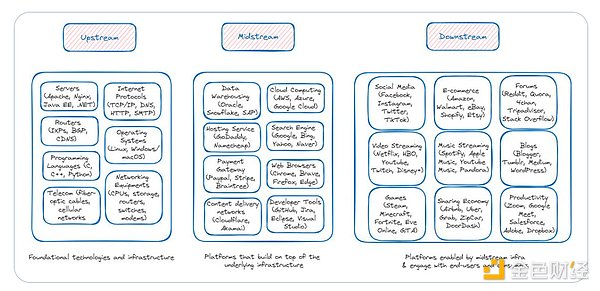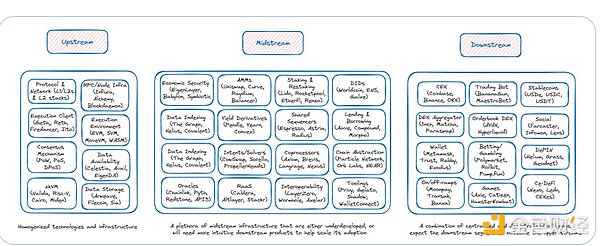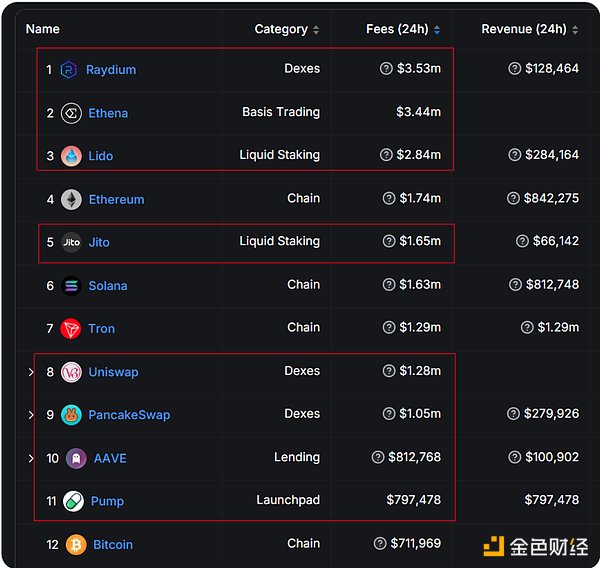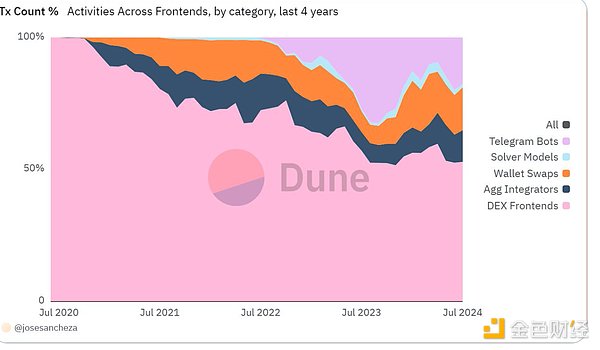Author: Richard Yuen,Velocity Capital Co-founder Source: X,@Richard__Yuen Translation: Shan Ouba, Golden Finance
The downstream front-end application layer will become one of the largest components of the on-chain economy.
Many people call for more applications, but for the wrong reasons - this is not about VCs trying to hype their infrastructure projects, nor is it about finding the next 100x speculative story.
Here aresome thoughts, or some random thoughts.
1/ Value Chain – Upstream, Midstream and Downstream
To help understand how the crypto/blockchain space might evolve, we can look to how mature industries like the Internet have evolved.
In mature Internet industries, the value chain can be divided into upstream, midstream and downstream.
Upstream – The underlying technology and infrastructure that supports the Internet; including hardware, connectivity and networks, core software and protocols, etc.
Midstream – Platforms built on top of the infrastructure; including data storage, cloud computing, hosting services, search engines, etc.
Downstream – Platforms that are supported by the midstream infrastructure and interact with end users and consumers; including applications such as social media, streaming, e-commerce, blogs, forums, etc.

The upstream of the value chain typically involves the development of underlying technologies and includes the development of core protocols and software on which midstream platforms operate. Midstream platforms act as a critical link—ensuring compatibility, optimization, and seamless integration between upstream infrastructure and technology providers and downstream consumer-facing platforms. Downstream platforms are the primary interface and delivery channel for interaction with end users, through which users access and use the products and services provided.
The infrastructure provided by upstream and midstream platforms enables downstream applications to offer diversified products and meet the needs of end users through endless iterations.
Upstream and midstream infrastructure usually have strong technology moats, high homogeneity, and limited product differentiation. Although they are often commoditized, they can still maintain high profit margins due to their strong technology moats (such as Amazon AWS), and some even become public products.
Downstream application technology moats are weaker, but product offerings have clear value propositions to attract users, with a focus on retaining users and building moats through strong network effects. Many companies will expand horizontally to provide a wider range of products, and some companies will even vertically integrate the entire value chain as they expand. Upstream and Midstream Platforms - B2B - Downstream Applications - B2C
As the blockchain/crypto industry evolves, I expect the value chain to eventually form the following three main schools:

Upstream - basic technologies and infrastructure supporting blockchain adoption; including protocols and networks (L1/L2), RPC/node infrastructure, execution and consensus clients, execution environment, consensus mechanism, data storage, zkVM, DA, etc.
Midstream - Platforms built on top of blockchain infrastructure; including economic security, AMM, yield derivatives, intent/solvers, oracles, RaaS, staking and re-staking, shared sorters, interoperability, DID, lending markets, chain abstraction, data indexing, etc.
Downstream - Applications supported by upstream infrastructure; including CEX, DEX aggregators, order book DEX, trading robots, games, Ce-DeFi, fiat-to-crypto conversion, wallets, DePIN, social, gambling/betting, stablecoins.
2/ Key Observations/Thoughts:
Upstream crypto infrastructure is becoming homogenous. Infrastructure projects are largely built on the same standardized mechanisms - e.g. PoS, EVM compatibility, etc. Core services and functionality are minimally differentiated. While some projects may offer a degree of specialization or unique features, the overall functionality offered by these upstream players is largely comparable.
This homogenous nature of upstream products will ultimately lead to price competition as they strive to differentiate on factors such as price, performance, and developer relationship management (e.g. commoditization of block space). Creating brands and network effects will be more important than ever to ensure upstream players remain relevant in the face of competition.
It seems strange that upstream infrastructure such as L1/L2s have primarily undertaken the bulk of retail customer acquisition, as their business models are very B2B. Broadly airdropping billions of dollars to users of multiple downstream applications seems highly inefficient. Imagine Amazon AWS spending billions of dollars to help its downstream customers such as Robinhood attract retail traders or Netflix attract viewers - it is difficult to develop appropriate user acquisition and retention incentive strategies without understanding the nuances of the product, user behavior/segmentation, engagement metrics, etc. As a result, billions of dollars end up being lost to attract airdrop farmers and transient users who churn once the incentive ends.
Midstream crypto infrastructure may face the same fate, becoming homogenized and eventually commoditized. For DeFi "apps" like Uniswap, Aave, and Pendle, I intentionally categorize them as midstream because there is limited differentiation between players in the same sub-sector, and they need intuitive downstream applications (such as front-end aggregators/CeDeFi platforms) to provide better user experience and scale. The user experience they currently provide mainly caters to crypto-native users (let's be honest: for most non-native users, setting up and funding a hot wallet, navigating to a DeFi app, choosing the right product/trading pair, choosing the right chain, confirming transactions, etc. is a very painful process).
Many midstream infrastructures are still in the iteration phase (especially intent layer/solver network, coprocessors, shared sorting, chain abstraction) - as the technology matures, this area will enhance the functionality of downstream applications - faster/cheaper/more precise execution and calculation, better interoperability, smoother user experience...
The downstream crypto application space is far from mature. It is expected that the scale of the downstream sector will exceed that of the upstream sector - similar to the market structure we see in mature industries.
Two major categories of downstream applications - centralized and decentralized. Centralized applications (CEX, CeDeFi platforms, fiat-to-crypto conversion services) provide a more intuitive UI/UX similar to Web2 platforms, with minimal onboarding friction, usually in compliance with regulatory requirements, and most have found some kind of product-market fit. Decentralized applications leverage and aggregate upstream infrastructure as their backing, while providing front-end interfaces, bringing a smoother user experience and reducing user friction. This sector will be at the forefront of accelerating mass adoption of blockchain technology and cryptocurrencies.
Vertical Integration - Seeing a trend where downstream applications that have found PMF begin to vertically integrate across the value chain and scale horizontally to provide a wider range of services. This phenomenon is not unheard of - Amazon online bookstore (downstream) built its own logistics/fulfillment network (midstream) and cloud-based infrastructure (upstream) to support its e-commerce and other internal operations, and scaled its e-commerce offerings horizontally to every retail category. In the crypto space - consider CEXs like Binance and Coinbase (downstream) launching BNB Chain and Base (upstream), incentivizing the integration and construction of midstream infrastructure, and scaling horizontally to provide a wider range of products - wallets, staking services, fiat-to-crypto conversion, custody, etc.; or consider the game Axie Infinity (downstream) launching Ronin Chain (upstream), and all midstream applications/infrastructure - Ronin Wallet, Katana (DEX), Mavis Market (NFT Market), Ronin Launch Platform, Mavis ID (DID), Ronin RPC, etc.
I expect the burden of customer acquisition to shift from upstream infrastructure back to downstream applications. This will be driven by: 1) L1/L2 ecosystems airdropping directly to applications, giving them discretion to design incentive plans based on their respective roadmaps, product designs, and business models; 2) VC, L1/L2, and retail capital re-rating downstream applications to fund growth in this space.
3/ Applications in the middle/downstream of the value chain will accrue the most value
Value creation - Upstream infrastructure creates value through groundbreaking technology innovation, improving the performance, efficiency, and reliability of the underlying system. Midstream platforms create value by packaging upstream technology products into developer-oriented applications, platforms, or ecosystems to solve specific market needs. Downstream players create value by leveraging midstream and upstream infrastructure to enhance the usability, accessibility, and personalization of their products.
Current state - Upstream/midstream infrastructure has gone through 2-3 rounds of technology iterations. Much of the value created by technological advancement is already reflected in the growth of market capitalizations in these areas. Innovation has plateaued, and technology is becoming homogenized. Downstream applications, on the other hand, are likely to experience unprecedented growth in this/next cycle due to value creation in leveraging mature upstream infrastructure.
In a mature industry, downstream platforms/applications typically receive the most attention because they are essentially the only interface for user interaction. Users won’t even know (nor care) about the backend stack built by these downstream applications. What users care about most is the user experience brought by these applications.
Through strong network effects (user base) and differentiated product offerings, downstream platforms are able to have higher pricing power and be given higher valuations.
Considering that ByteDance (TikTok’s parent company), with 50 million+ daily active users, generated $120 billion in revenue and was valued at $268 billion in 2023; while Akamai (CDN network), on which it relies, generated $3.8 billion in revenue and had a market capitalization of $1.6 billion; the same applies to Meta, Netflix, Google, etc.
Value flows from downstream applications that monetize through a large network of paying users, to midstream, and ultimately to upstream participants. The growth of downstream applications will eventually promote the growth of the upstream technologies they rely on, and this relationship is symbiotic.
We have seen crypto applications accumulate fees that exceed upstream infrastructure - midstream (Raydium, Uniswap, PancakeSwap, Aave, Lido, Jito); downstream (Ethena, Pump). Upstream infrastructure such as Avalanche, Near, Polygon, etc. have faded from the stage, generating only $10,000 to $100,000 in fees per day.

Consider only the comparison between Uniswap and Ethereum: a user trades $100,000 on Uniswap and pays $1 in network transaction fees to Ethereum, but Uniswap earns $300+ from transaction fees + MEV profits - it is obvious which layer accumulates more value.
4/ Popularization of Profit Maximization
Downstream applications on L1/L2s are charged gas fees (L1 security fees and/or L2 execution fees) for user activities on the one hand, while also being exploited by block builders of upstream L1/L2s for MEV, leaving a lot of money.
Intuitively, in order to maximize revenue sources, many downstream applications begin to explore the possibility of taking back sovereignty over revenue generation.
Downstream applications are expected to further privatize their order flows, build their own private memory pools through vertical integration, and even become block builders. Some applications may even launch their own application chains as a means of capturing more value.
Consider front-ends such as Banana Gun TG bot - expected to pay more than $100 million to Ethereum builders and validators as priority fees and miner tips. Already 98% of order flow goes through private memory pools. It would not be surprising if Banana Gun further expanded vertical integration to run block construction to capture more value.
Some applications choose to build their own application chain to optimize for the application's blockchain architecture (throughput requirements, consensus algorithms, application-specific data structures, customized gas fees and economic incentives, sovereignty, etc.), enabling it to scale more efficiently than general-purpose blockchains. Value capture will also be concentrated on the application chain rather than "revenue sharing" with the base layer blockchain.
It is expected that as solver networks (Fastlane Atlas, Semantic Layer, Uniswap V4 hooks), interoperability and chain abstraction infrastructure, RaaS and rollup stacks (OP stack, ZK stack, Arbitrum Orbit, etc.) mature and become more popular, the profitability of applications will be further improved, thereby better capturing value in the future.
5/ The “Front-end Reversal” Meta-Trend
Downstream front-end applications that provide a smooth user experience will be at the forefront of attracting millions of non-crypto native users. Midstream applications like Curve, Aave and upstream infrastructure will instead become the backstop for execution and settlement.
I am particularly bullish on the following front-end applications: trading bots/wallet built-in trading that provide a chain abstracted trading experience with optimized transaction execution and low fees; order books/central limit order books that provide a Web2-like trading experience with faster execution/lower fees; payment super applications that provide fiat-to-crypto conversion solutions + seamless P2P Venmo-like stablecoin transfer experience; social applications and games that cleverly combine financialization + asset ownership + AI to create experiences that can compete with Web2 applications.
The “Front-end Reversal” is happening.
Consider downstream front-ends like Jupiter and 1inch, whose fee revenues are already comparable to Uniswap and PancakeSwap. Or consider front-ends like TG bot+wallet trading+aggregator, which already accounts for about 50% of all transactions on Ethereum.

Downstream front-ends are eating into the market share of midstream back-end applications. As these front-ends become the de facto standard for interacting with DeFi, the market share of back-end applications is expected to decline further.
The reversal of front-end fat applications is inevitable.
 JinseFinance
JinseFinance










